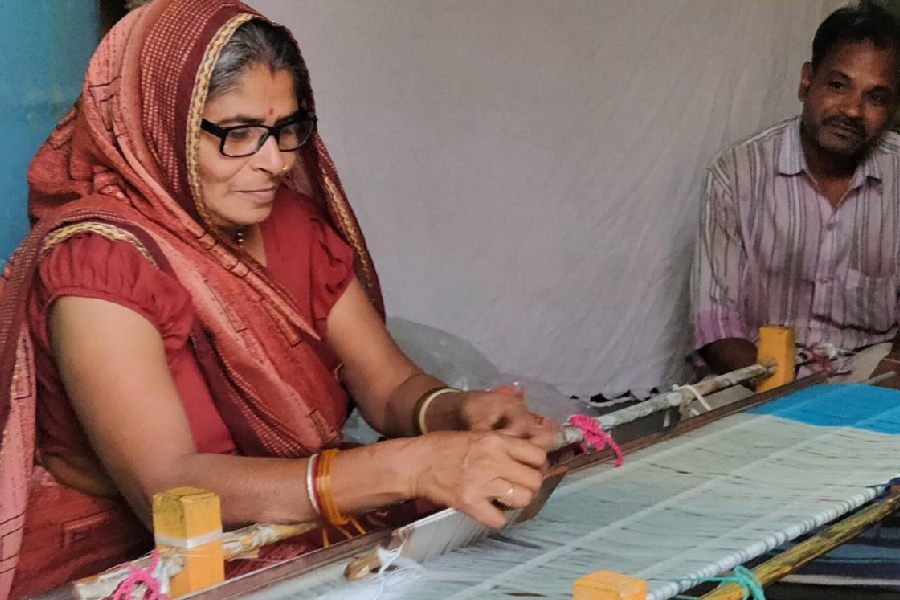First-time voter Brijesh Koli has no doubt about whom to vote for on May 7, but wonders when he would be able to have his own handloom and clientele.
His hopes are high thanks to the tag of “Craft Handloom Tourism Village” that his native Pranpur gained in March.
Set in the Chanderi tehsil of Ashoknagar district in Madhya Pradesh, 210km north of Bhopal, the village is known for its weavers who make the famed Chanderi saris and other textiles on their handlooms. Almost all the weavers here are from the Koli community of Dalits.
“Rainwater used to flood this place. (Union minister Jyotiraditya) Scindiaji fixed this by getting the lanes paved with stone slabs. He also contributed to the renovation of many homes,” Brijesh told The Telegraph.
Scindia switched from the Congress to the BJP in 2020, a year after his first electoral defeat from the Guna parliamentary seat, under which Pranpur falls. The Scindia royal family of Gwalior has held Guna for most of its electoral history. Scindia is now the BJP candidate from here.
Brijesh shows off his village, where walls are freshly painted with colourful traditional murals. The Madhya Pradesh government inaugurated this weavers’ village in its new avatar after spending ₹7.45 crore on sprucing up the place.
For most of the 450-odd weaver households here, the Scindias — irrespective of party affiliation — are a synonym for government.
“Earlier, the seths (traders) were the only point of sale. They even cut the wastage of yarn from our wages. We were in constant debt to moneylenders and many migrated to become wage labour,” elderly weaver Ramesh Badkul said.
“Around 40 years ago, Madhavrao Scindiaji (Jyotiraditya’s father and Congress minister) introduced us to companies, and set up institutions to directly buy from us. The yarn we used was too fine and we wasted most of our time sorting it. Scindiaji introduced us to thicker yarn from China that made our job much easier. Now the yarn comes from Bengaluru.”
Although a state-level cooperative exists, most weavers sell to traders and private firms.
A newer category of tourist buyers, locally referred to as “madams” — urban women who can afford and appreciate the art — pays at least ₹200 more per sari than the seths and the companies. This is still less than two-thirds of the retail price charged at leading outlets in the metros.
For a simple sari that costs around ₹2,500 and takes more than a day to make, the weavers make only up to ₹500. They get paid more for the more elaborate saris that cost up to ₹1 lakh. Weavers who have their own looms earn more than those who don’t. A loom costs around ₹30,000.
The loom-less weavers work on the looms of richer weavers or seths for a smaller share of the making rate.
Pranpur has a large hall or handloom park where several such weavers work. The youngest of them at work, when this newspaper visited the village, was 17-year-old Deepesh, who started working after his parents died.
Children as young as eight sit by the side of their parents as they work on the looms, and learn the craft.
“About 2,000 weavers have got looms (with a 90 per cent subsidy) from the (Union) government under the Hathkargha Samvardhan Sahayata scheme. But around 450 are yet to get it,” said Hargovind Koli, who works at the park.
“I will try and educate my children. But if I can’t afford to pay for their higher studies, they will also have to weave. Many of our children study and weave but few go beyond school, which is only up to Class X here.”
The weavers don’t take a weekly day off, and hope that Pranpur’s primary health centre would be upgraded to a hospital so they don’t lose income taking the seriously ill to hospitals in Chanderi, Ashoknagar or Bhopal.
Badkul’s son Hemant is a Scindia fan like his father but wants more from life. His brother Bharat, also a weaver, plays the tabla as well and hopes this would entertain tourists once they come in larger numbers.
Hemant told this newspaper: “There should be a pension for weavers after they turn 60, which should be higher than the general ₹600 pension that any senior citizen gets. We need alternative employment for our youth as everyone can’t be employed in weaving. Because of inflation, we can’t afford to send our children to study outside after they have finished Class X from the local school.”
He added: “We need help in selling our saris directly. I registered under the Handloom Mark central scheme in 2021 but I don’t know how to sell at larger volumes. And we are still dependent on the seths. When we try to sell on social media, people think we are frauds. How do we convince them that we are the real weavers?”











